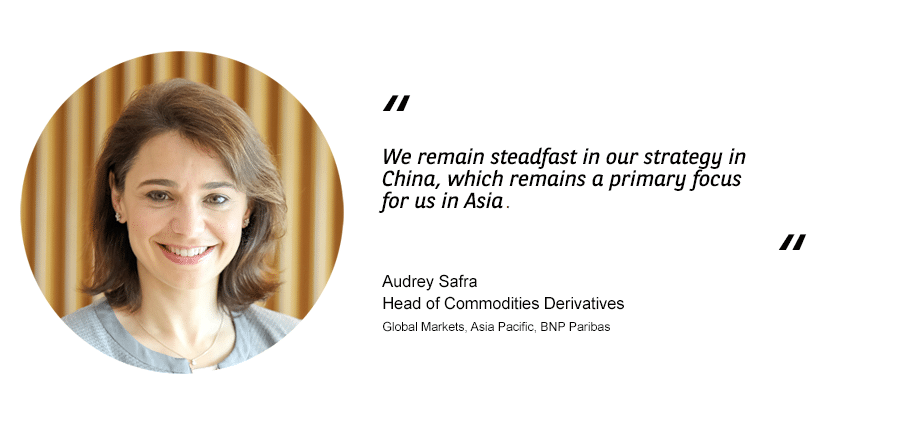This article originally appeared in Risk.net under the title “Derivatives house of the year, Asia: BNP Paribas”.
Trade wars and geopolitics might be darkening the macroeconomic picture for China, but the country’s ongoing integration into the global economy is an inescapable fact – and one that continues to be a growing source of business for BNP Paribas’ commodity derivatives operation.
“We remain steadfast in our strategy in China, which remains a primary focus for us in Asia,” says Audrey Safra, the Singapore-based head of commodities derivatives, Asia Pacific, within BNP Paribas’ Global Markets division. “Even with the market pricing in a slowdown in business activity caused by the ongoing US-China trade dispute, our onshore China derivatives business posted remarkable growth of 80% compared with last year.”

That growth contributed to an overall 20% step-up in revenues from the region’s commodity derivatives operation, says Safra, helping the bank win Derivatives house of the year for the second year in a row in the Energy Risk Asia Awards 2019. It represented an increase in both the number of clients the bank is servicing and in the range of risk management products it is offering.
Of particular note is the bank’s push on precious metals in China, where it has become one of the few overseas banks to become a member on the Shanghai Gold Exchange main board. “This will provide us with the ability to structure solutions such as gold leasing,” says Safra.
Meanwhile, BNP Paribas has broadened the suite of freight derivatives it offers, including moving into options, explains Nishan Hegde, Asia Pacific commodity sales in Global Markets at BNP Paribas.
The high implied volatility of freight options – caused by low liquidity in the underlying swap market – makes it a challenging market in which to operate as a market-maker, says Hegde. While implied volatility in gold options tends to land around the 15% mark, and around 40–45% in iron ore, in dry freight it is nearer 100%, he says.
But high volatility can also present opportunities. “There are trades where high volatility can work to the benefit of clients,” he says, in that it can allow clients to enter into collars, where they sell a put and buy a call, with the revenue from the former used to reduce (or eliminate) the cost of the latter. Hegde adds that BNP Paribas’ willingness to “warehouse freight volatility is what differentiates us from other banks”.
Supporting the energy transition movement has been central for BNP Paribas, with commodity derivatives playing its part.
Staying with freight, Safra notes strong demand from shipping companies seeking to put on commodity hedges to help underwrite the costs of fitting scrubbers. This costly equipment removes smoke-stack emissions of sulphur dioxide, enabling ships to meet the International Maritime Organization’s 2020 rules, while also allowing them to continue to use cheaper, high-sulphur fuel oil.
“Once a ship owner has decided to install scrubbers, they become exposed to the differential between the cost of gasoil and the fuel oil,” she says. “We’ve been working closely with the shipping industry to develop hedges for this exposure.” By locking in the savings that ship owners can access from continuing to use fuel oil, they can help finance the capital expenditure required to fit scrubbers.
The bank is also responding to growing demand for petrochemicals hedges and has assigned a trader in London to focus on the sector. However, given that physical petrochemicals supply is often found in Asia, and demand in Europe, successfully offering risk management products requires a capacity to bring together pools of liquidity from the two regions, Hegde says. “The idea is to try to bring European liquidity to the Asian time zone and vice versa,” he says.
The bank faces similar challenges in natural gas, where liquidity is fragmented between the various pricing points, such as Henry Hub and the Japan/Korea marker (JKM). “Part of the value we add is in our ability to provide liquidity for Henry Hub, for example, in early London time,” he adds. “We can take on the correlation risk that comes on when you trade JCC [Japan customs-cleared crude] and JKM, especially over longer tenors.”
Safra adds that BNP Paribas’ metals trading capacity – including in the physical market – has helped support the bank’s financing business. She gives the example of an Asian London Metal Exchange-brand copper producer, which was seeking $130 million of medium- to long-term working capital. The ability of BNP Paribas to pull together a syndicate of banks to provide the debt depended upon BNP Paribas agreeing to act as offtaker for its output, she explains.
“Because we can trade the physical metal, it provided a layer of security around the structure,” she says. “Our involvement gave the other lenders a good degree of confidence that there was a high-quality offtaker involved.”

Looking forward, Safra says the bank’s overall push on sustainability is becoming an increasingly important part of its relationship with its customers in commodity derivatives.
“Supporting the energy transition movement has been central for BNP Paribas, with commodity derivatives playing its part,” she says. “When we talk to clients, we always raise the topic with them…explore how it might be relevant to them and how we can do more.”
